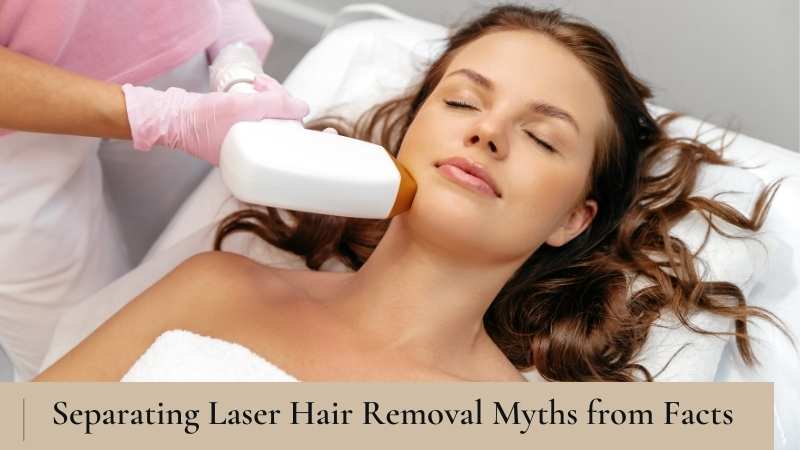
Laser hair removal has attained popularity in recent years as a cost-effective and convenient method for eliminating body hair in the long run. But, along with its growing popularity, several misconceptions and myths have surfaced. Such myths often create unwanted concerns and influence people’s judgment. This, in turn, stops them from unleashing the benefits of this hair-removing procedure. Keep reading as we debunk the common myths and misconceptions about laser hair removal to clear all your doubts.
Common Myth and Facts about Laser Hair Removal
Myth #1: Laser hair removal can be extremely painful
Expert Insight: You might experience slight discomfort during laser hair removal treatment when the light energy vaporizes the follicles, which can be tolerated [1]. The pain similar to a snap on your skin experienced during laser sessions is generally mild and lasts only briefly.
Fact: A common myth surrounding laser treatment for hair removal is that it can be very painful. But, in reality, people undergoing laser therapy describe the sensation as a slight pinch or rubber band snap feel, which is manageable. Advanced lasers are based on photothermolysis to target hair follicles and are designed with the latest cooling devices or mechanisms. It keeps the skin cool during treatment to avoid the discomfort. Plus, each laser hair removal session is quick, lasting only a few minutes to 30 minutes, based on the treatment site. For hair removal in sensitive areas, your skin specialist will apply numbing cream to alleviate discomfort. Laser hair removal is not painful compared to traditional hair removal methods like waxing.
Myth #2: Laser Hair Removal Is Ideal for Light-Skinned People
Expert Insight: The laser technology can be performed on all skin types, as it can be customized with longer or shorter wavelengths to eliminate the follicles. So, people with varied skin tones can explore this hair removal option. However, laser treatment is unsuitable for people with tanned skin, and you can take up the treatment as soon as the tan subsides.
Fact: This is yet another misconception that has made people believe that dark-skinned people with dark and coarse hair are not suitable candidates for laser hair removal. Significant advancements in laser hair removal technology have paved the way for developing different types of lasers to cater to the needs of varied skin tones. Consult an expert dermatologist to suggest the right laser type based on your specific hair colour and skin tone according to the Fitzpatrick scale [2].
Myth #3: Just One Session of Laser Hair Removal Will Fix Your Body Hair
Expert Insight: You must attend multiple laser sessions to achieve hair-free skin, as your hair will have different growth cycles. You will lose around 20% of your hair after the first laser appointment [3].
Fact: People believe in the misconception that undergoing a single laser session will help them get rid of their body hair completely. Some people even think they can walk hair-free from the skin clinic as soon as their first session ends. However, the entire laser hair removal process is divided into several sessions based on parameters like skin tone, hair texture, and colour. If you have thick and dark hair, then you might need more sessions than your counterparts with light hair [4]. Laser hair removal is performed by targeting the follicles of the hair in the anagen or active growth stage for effective results [5]. So, in each session, those hair follicles in the anagen phase will be eliminated [6]. So, you will notice a visible difference in hair reduction as each session advances.
Myth #4: Laser Hair Removal Is a Time-consuming Process
Expert Insight: Laser hair removal sessions are brief for areas like the upper lip or eyebrows. It may take about 45 minutes for large treatment areas.
Fact: An exert dermatologist will need just a few minutes to remove hair on your upper lip or chin, as the treatment site is small. For larger body areas like your back, legs, or arms, it might take around 45 minutes to an hour. You must take 6 to 8 sessions to eliminate about 90% of your body hair. So, you just need a couple of months to flaunt a hairless beach body.
Myth #5: Laser Hair Removal Is Not Safe For Your Skin
Expert Insight: Laser hair removal is an FDA-approved procedure that is safe for skin of all types [7]. There are no serious side effects or complications when your skin interacts with the laser energy [8].
Fact: All reputed skin clinics use only FDA-approved laser hair removal equipment and cooling devices, which are safe for even sensitive skin. When expert skin specialists handle your laser sessions, you need not have any concerns about the safety of your skin [9]. Consult your dermatologist and seek an opinion regarding the best type of laser to treat your specific skin type, tone, hair thickness and colour [10].
Myth #6: Laser Hair Removal Procedure Will Expose You to Radiation
Expert Insight: The FDA-approved laser doesn’t contain radioactive materials, making it very safe. The cosmetic lasers used for hair removal don’t have any carcinogenic effect, which is why it is safe for people of all ages [11].
Fact: It is a popular myth that laser usage can lead to cancer. Laser devices used for hair removal do not have ionizing radiation, which causes cancer [12]. Laser devices are designed to deliver non-ionizing radiation, which is safe for you. Laser hair removal technology is developed to focus the light rays on the hair follicles found in the skin while protecting the tissues surrounding it.
Myth #7: At-Home Laser Kits Are Equally Effective Like Professional Laser Treatment For Hair Removal
Expert Insight: When getting laser hair removal at a renowned skin clinic, there are no risks like infections, burns or damage, which is not the case with DIY kits. Expert dermatologists would assess your skin type and hair texture to determine the type of laser for effective hair removal. For instance, Nd: YAG laser with wavelengths ranging from 755 nm to 1064 nm will be used for dark-skinned people [13]. IPL, diode [14], or Alexandrite lasers will be the best choice for people with lighter and medium skin tones [15].
Fact: As the market is flooded with DIY laser kits for hair removal, many are tempted to try it at home. These at-home devices are inferior in precision, quality, and power compared to professional-grade FDA-approved laser equipment. Laser hair removal at home can be risky when not performed by a skilled and expert professional. When trying the DIY kit at home, you might face uneven skin tone, pigmentation, ineffective hair reduction, and burns [16].
Myth #8: Laser for Hair Removal Will Cause Too Much Ingrown Hairs
Expert Insight: Laser hair removal kills the root of the hair, which indicates that it will reduce the incidences of ingrown hairs. You will see an eventual reduction of ingrown hairs after each laser session. Experienced technicians ensure that every follicle in the active growth stage is targeted and eliminated during professional laser treatments [17].
Fact: The fact is that laser hair removal lowers the occurrence of ingrown hairs, which develop by growing into the skin instead of outwards. This hair removal method employs high-intensity laser light that focuses on weakening the follicles to decrease hair regrowth and thick texture [18]. As hair follicles are completely vaporized, laser sessions reduce the appearance of ingrown hairs.
Myth #9: Laser Hair Removal Is Suitable Only For The Young
Expert Insight: This myth is wrong; laser treatment for hair removal can be available to people of all ages once they have completed puberty.
Fact: Laser hair removal is perfect for people of all age groups ranging from those in their 20s to 50s [19]. The body hair of people in different age groups is possible, but the number of sessions per individual might vary based on age. As soon as an individual is past puberty, they are eligible for laser therapy as their hair growth will be stabilized by then.
Myth #10: Laser Hair Removal Sessions are Very Pricey
Expert Insight: People who wish to remain hair-free tend to spend more on depilatory creams, waxing, or shaving, which have a high upfront cost. Compared to these traditional methods to eliminate hair temporarily, the cost of laser hair removal is less to achieve a hair-free effect in the long run.
Fact: Each month, you might have to spend several bucks to buy a new pack of hair-removing cream or a razor or waxing strips to keep your body hair away for a few weeks or days. The cumulative costs of these traditional hair removal products will be relatively high when compared with laser treatment. It is more permanent and doesn’t require much investment for maintenance.
Summing Up
It is always important to rely on professional advice for laser hair removal at Kolors Hair and Skin, as the team of skilled dermatologists can understand your specific needs. They are experts in customizing the laser based on your unique skin or hair type to avoid complications and get better results. Schedule an appointment with their skin specialist today and say help to smooth and beautiful skin.
Reference Links
- RoseLab Skin Optics Research Laboratory, Montreal, Quebec, Canada. – https://pubmed.ncbi.nlm.nih.gov/22437967/
- Ajay N. Sharma(UC – Irvine School of Medicine), Bhupendra C. Patel(University of Utah) – https://www.ncbi.nlm.nih.gov/books/NBK557626/
- Goel, A., & Rai, K. (2022). Methods to Overcome Poor Response and Challenges of Facial Laser Hair Reduction. The Journal of Clinical and Aesthetic Dermatology, 15(6), 38-41. https://www.ncbi.nlm.nih.gov/pmc/articles/PMC9239120/ – https://www.ncbi.nlm.nih.gov/pmc/articles/PMC9239120/
- Department of Dermatology, STD & Leprosy, Government Medical College, Srinagar, India – https://www.ncbi.nlm.nih.gov/pmc/articles/PMC7190465/
- Lin, T. D., Manuskiatti, W., Dierickx, C. C., Farinelli, W. A., Fisher, M. E., Flotte, T., Baden, H. P., & Anderson, R. R. (1998). Hair Growth Cycle Affects Hair Follicle Destruction by Ruby Laser Pulses. Journal of Investigative Dermatology, 111(1), 107-113. https://doi.org/10.1046/j.1523-1747.1998.00227.x – https://www.sciencedirect.com/science/article/pii/S0022202X15401393
- Kolinko, Vladimir, Littler, Curt, Cole, Adam – Influence of the anagen:telogen ratio on Q-switched Nd:YAG laser hair removal efficacy – https://www.researchgate.net/publication/12677481_Influence_of_the_anagentelogen_ratio_on_Q-switched_NdYAG_laser_hair_removal_efficacy
- Lim, S & Lanigan, S. (2006). A review of the adverse effects of laser hair removal. Lasers in medical science. 21. 121-5. 10.1007/s10103-006-0377-y. – https://www.researchgate.net/publication/6967750_A_review_of_the_adverse_effects_of_laser_hair_removal
- Lasercare and Birmingham Skin Centre, City Hospital, Dudley Road, Birmingham, B18 7QH, UK – https://pubmed.ncbi.nlm.nih.gov/16816888/
- American Academy of Dermatology – https://www.aad.org/news/common-misconceptions-about-laser-hair-removal
- Washington Institute of Dermatologic Laser Surgery, Washington, D.C., USA – https://pubmed.ncbi.nlm.nih.gov/9865211/
- Washington Institute of Dermatologic Laser Surgery, Washington, D.C., USA – https://www.cancer.org.au/iheard/can-laser-hair-removal-cause-cancer
- University of Wales Trinity Saint David, Swansea, SA1 6ED UK – https://www.ncbi.nlm.nih.gov/pmc/articles/PMC5653718/
- Tina S. Alster, MD; Holly Bryan, BS; Carmen M. Williams, MD: Washington Institute of Dermatologic Laser Surgery, Washington, DC. – https://jamanetwork.com/journals/jamadermatology/fullarticle/478428
- Załęska, I., & Atta-Motte, M. (2018). Aspects of Diode Laser (805 nm) Hair Removal Safety in a Mixed-Race Group of Patients. Journal of Lasers in Medical Sciences, 10(2), 146-152. https://doi.org/10.15171/jlms.2019.23 – https://www.ncbi.nlm.nih.gov/pmc/articles/PMC6499570/
- Autoimmune Bullous Diseases Research Center, Tehran University of Medical Sciences, Tehran, Iran – https://pubmed.ncbi.nlm.nih.gov/34733744/
- Hendricks, K., Nxumalo, C. T., Makgobole, M. U., Ghuman, S., Jacobs, D., & Mpofana, N. (2023). Evaluating the effectiveness of laser hair reduction using a home use laser in comparison to a Diode laser. PLOS ONE, 18(5). https://doi.org/10.1371/journal.pone.0286162 – https://www.ncbi.nlm.nih.gov/pmc/articles/PMC10218747/
- Arielle N. B. Kauvar, MD: Laser and Skin Surgery Center of New York, New York, NY – https://jamanetwork.com/journals/jamadermatology/fullarticle/190787
- Schuler, A., Veenstra, J., & Tisack, A. (2020). Folliculitis Induced by Laser Hair Removal: Proposed Mechanism and Treatment. The Journal of Clinical and Aesthetic Dermatology, 13(5), 34-36. https://www.ncbi.nlm.nih.gov/pmc/articles/PMC7380697/ – https://www.ncbi.nlm.nih.gov/pmc/articles/PMC7380697/
- Sandy S Tsao MD, George J Hruza MD, in Surgery of the Skin, 2005 – https://www.sciencedirect.com/topics/medicine-and-dentistry/laser-hair-removal

Very insightful and informative blog. Keep up the good work team.